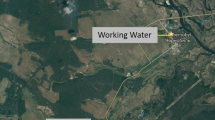Abstract
Coastal distribution in the northern hemisphere 131I originating from Chernobyl was estimated using standard gamma spectrometric techniques on samples of the intertidal seaweed, Fucus. In May and June 1986 synchronized Fucus spp. collections were made from several locations around the world with emphasis on the northeast Pacific shores. The large-scale patterns of 131I specific activity was consistent with prevailing tropospheric wind conditions. In British Columbia and Washington State, specific activity correlated significantly and positively with precipitation. A detailed study of a Fucus population in Vancouver, British Columbia, suggested that plants became contaminated by rain-borne 131I during periods of emergence. This population had detectable levels of 131I for about 40 d, and a bio-elimination half-period of 10.3 d.
Similar content being viewed by others
Literature cited
Anderson, A. (1986). Making the most of Chernobyl. Nature, Lond. 322: 673
Anonymous (1974). Climates and the states. Vol. 2, western states (including Alaska and Hawaii). Water Information Center Publ., National Oceanic and Atmospheric Adm., U.S. Dept. of Commerce
Anonymous (1982). Canadian climate normal. Vol. 3, Precipitation, 1951–1980, Can. Clim. Progr.
Anonymous (1986). Chernobyl fallout: corrigendum. Nature, Lond. 321: 643
Butler, G. C. (1980). Radioactivity in the Canadian environment. NRC Canada, Publ. NRCC 18134
Goldberg, E. D., Bowen, V. T., Farrington, J. W., Harvey, G., Martin, J. H., Parker, P. L., Roseborough, R. W., Robertson, W., Schneider, E., Gamble, E. (1978). The mussel watch. Environ Conserv. 5: 101–125
Guimaraes, J. R. D., Penna-Franca, E. (1985). 137Cs, 60Co and 125I bioaccumulations by seaweeds from the Angra dos Reis nuclear plant region. Mar. Environ. Res. 16: 77–93
Hevano, S., Islui, T., Nakamura, R., Matsuka, M., Koyanagi, T. (1983). Chemical forms of radioactive iodine in seawater and its effects upon marine organisms. Radioisotopes 33: 319–322
Klemperer, H. G. (1957). The accumulation of iodide by Fucus ceranoides. Biochem. J. 67: 381–390
Law, J. J. (1975). Instrumental neutron activations analysis for iodine in seaweeds. Texas J. Sci. 26: 93–98
Lederer, C. M., Shirley, V. S. (1978). Table of isotopes. 7th edn John Wiley and Sons, New York
Oort, A. H., Rasmussen, E. M. (1971). Atmospheric circulation statistics. NOAA professional paper No. 5, U.S. Dept. Commerce, Rockville
Popham, J. D., Johnson, D. C., D'Auria, J. M. (1980). Mussels (Mytilus edulis) as point source indicators of trace metal pollution. Mar. Pollut. Bull. 11: 261–263
Riley, J. P. (1965). Analytical chemistry of sea water. In: Riley, J. P., Skirrow, G. (eds.) Chemical Oceanography. Vol. 2. Academic Press, London, p. 295–424
Saenko, G. N., Krautsova, Y. Y., Ivanenko, V. V., Sheludko, S. I. (1978). Concentration of iodine and bromine by plants in the seas of Japan and Okhotsk. Mar. Biol. 47: 243–250
Smith, F. B., Clark, M. J. (1986). Radionuclide depositions from the Chernobyl cloud. Nature Lond. 322: 690–691
Tokala, K., Olkkoven, H. (1981). Lead content of an epiphytic lichen in the urban area of Kuopio, east central Finland. Ann. Bot. Fenn. 18: 85–89
Tseng, C. K. (1981). Commercial cultivation. In: Lobban, C. S., Wynne, M. J. (eds.) The biology of seaweeds. Botan. Monogr. 17: 680–725
Uematsu, M., Duce, R. A. (1986). Tracking the Chernobyl plume across the pacific. Maritimes 30: 1–4
Woodwell, G. M. (1967). Toxic substances and ecological cycles. Sci. Am. 216: 24–31
Young, G. E., Langelle, W. M. (1958). The occurrence of inorganic elements in marine algae of the Atlantic provinces of Canada. Can. J. Bot. 36: 301–310
Author information
Authors and Affiliations
Additional information
Communicated by R. W. Doyle, Halifax
Rights and permissions
About this article
Cite this article
Druehl, L.D., Cackette, M. & D'Auria, J.M. Geographical and temporal distribution of iodine-131 in the brown seaweed Fucus subsequent to the Chernobyl incident. Marine Biology 98, 125–129 (1988). https://doi.org/10.1007/BF00392667
Accepted:
Issue Date:
DOI: https://doi.org/10.1007/BF00392667




